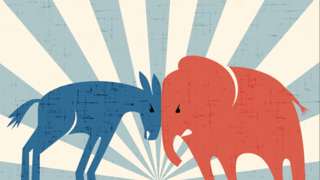President Donald Trump
Are There Signs We’re Becoming Less Polarized?
What the the midterms might be telling us.
Posted November 22, 2022 Reviewed by Vanessa Lancaster
Key points
- Political polarization is rising in the United States.
- New evidence suggests that party animosity comes first and informs the policy decision, not the other way around.
- But midterm voters in Ohio, Kansas and other states split their vote, voting for both a Republican and a Democrat.

Not many people would disagree that political polarization is rising in the United States. But look at the midterms: Extreme candidates didn’t fare so well. Sure, many of these elections were decided by tiny margins, and according to the Center for American Progress, 300 candidates on the ballot were election deniers. So maybe this isn’t the best test case.
Some Good News
Still, one big silver lining that may have been lost among the media focus on extreme candidates striking out or Republicans flipping the House is that voters did something pretty amazing in many states: They split their vote. Voting for a Republican and a Democrat seems about as far from being polarized as you can get—and voters did it in New Hampshire, Ohio, and Kansas, to name a few. So, what gives? How are we so polarized, and yet there’s evidence that we’re still rational human beings who are not all straight-lining down the party line?
Some people might say it’s because democracy was at stake during this election. Others may say it was because the abortion issue made people step away from their party for this one vote. Both of these reasons are probably true, and there’s also more to the story—starting with what it means to be polarized in the first place.
A Polarization Primer
For many years, political polarization was seen as the two parties simply disagreeing on the issues. But a funny thing happened again and again when political scientists did surveys looking at Americans’ policy beliefs. Democrats and Republicans weren’t all that different from each other ideologically. Sure, there were some issues where the parties were far apart, but for many, there was overlap. Lots of overlap.
If it wasn’t the issues people disagreed on so much, what was it? Social scientists started looking at polarization through a new lens. They said it’s simple: Partisans dislike and distrust those from the other party. The reason, according to researchers, has to do with social identity theory, which goes something like this: When people break into groups—Red Sox fans, 5K-runners, cilantro-haters—they can develop positive feelings for their ingroup and negative feelings for the outgroup. They may even separate themselves and minimize contact with the outgroup, and because of this distancing, they start to stereotype the outgroup.
One of the most influential groups people belong to is their political party. In The Power of Us, social psychologists Jay Van Bavel and Dominic Packer wrote that “U.S. Twitter users are adding political words to their bios at a higher rate than words associated with any other social identity. People are now more likely to describe themselves by their political affiliation than their religious affiliation.” The researchers behind this finding, Nick Rogers and Jason J. Jones, analyzed millions of Twitter bios over several years. Through this method, they were able to separate whether the change was simply because more politically engaged people were joining Twitter or if people already on Twitter were changing their bios. They found both to be true. New people joining Twitter were indeed more politically-oriented than the older participants, but also people already on the platform were amending their bios to be more political. Because of this, they concluded that national polarization is likely to get even worse.
Shanto Iyengar, a professor of political science at Stanford and one of the leading experts on affective polarization, would probably not be surprised. Research shows that the gap between Republicans and Democrats nearly doubled between 1978 and 2016 and continues to widen. Interestingly, according to Iyengar and his colleagues, this gap isn’t driven by in-party favoritism; it’s from animosity toward the other party. In other words, Republicans don’t just love other Republicans; they bond over not loving Democrats. Researchers even use the same scales to measure political animosity that they use to measure racial prejudice, such as the Bogardus Social Distance Scale.
Pollsters and political scientists have been interested in how the two parties feel about each other for decades. And there has been a big shift since they started tracking it in the 1960s. Back then, when Americans were asked if they would be upset if their son or daughter married a member of the other political party, the answer was almost, “huh?” Only 5 percent of Republicans, and 4 percent of Democrats, said they would be upset. The same question was asked again in 2020 by YouGov.com. This time, 38 percent of Republicans and Democrats said they would be upset.
How has polarization changed?
So what does this mean, other than having stressful Thanksgiving dinners? According to recent research by James Druckman, a Faculty Fellow at the Institute for Policy Research at Northwestern University, there may be a reason to think all of this disliking each other is impacting policy preferences, despite what we may have seen during the midterms. Their research about partisan responses to Covid-19 found evidence that people made decisions based on their dislike for the other party—even more than thoughts on the issues themselves. They also found that the more Republicans disliked Democrats, the less they worried about Covid-19; and that Democrats with the most disdain for Republicans were also the most likely to support policies to combat Covid-19.
This is a big deal. It suggests for the first time that party animosity comes first and then informs the policy decision, not the other way around. Perhaps the midterm elections are an indicator of more compromise and less animosity, and therefore less party influence on policy decision-making. Or, maybe the midterm results just mean the strategies will change. The New York Post and Fox News have both increased negative coverage of Trump. Maybe the midterms were more a referendum on Trump more than anything else—a message to the team to bench Trump, not forfeit the game.
References
Iyengar, S., Sood, G. & Lelkes, Y. Affect, not ideology: a social identity perspective on polarization. Public Opin. Q. 76, 405–431 2012.
Druckman, J. N., Klar, S., Krupnikov, Y., Levendusky, M., & Ryan, J. B. (2021). Affective polarization, local contexts and public opinion in America. Nature human behaviour, 5(1), 28-38.
Rogers, N., Jones, J.J., 2021. Using Twitter Bios to Measure Changes in Self-Identity: Are Americans Defining Themselves More Politically Over Time?. Journal of Social Computing 2, 1–13.. doi:10.23919/jsc.2021.0002




